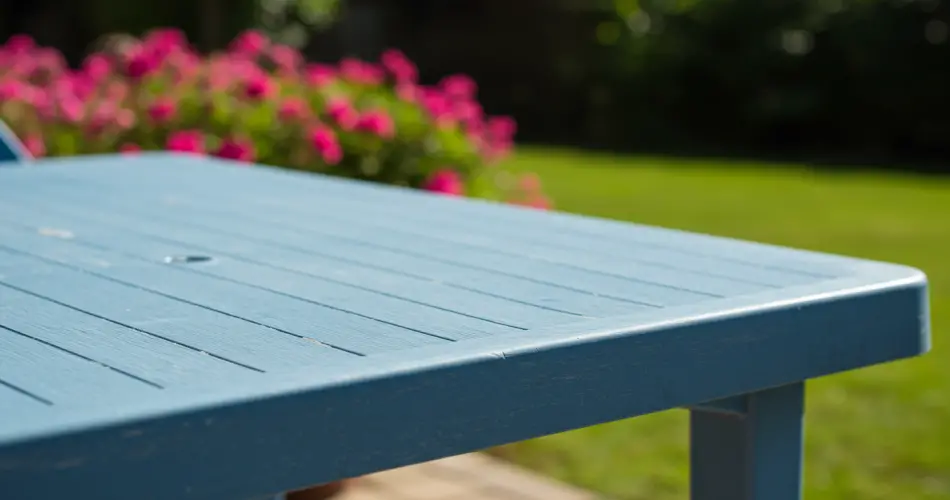A sturdy plastic garden table is one of the most practical choices for outdoor living. Whether it’s for relaxed afternoons under the sun or evenings spent dining with friends, this type of furniture is lightweight, durable, and easy to maintain—at least in theory. After months of exposure to the elements, however, plastic tables can start to look anything but appealing. Dirt, rain, and debris accumulate, leaving behind a dull, darkened, or even blackened surface. Many people assume the only solution is to replace the table with a brand-new one. Fortunately, cleaning experts reveal that a few simple steps and natural ingredients can restore your plastic garden table to its original condition.
Why Plastic Tables Become Dirty Over Time
Even if you cover your table with a protective tarp during the winter, moisture and grime still manage to work their way onto the surface. Rainwater leaves streaks, fallen leaves create stains, and dust settles in every crevice. After several months of neglect, the once-bright plastic may look stained and weather-beaten. Instead of rushing to the store for a replacement, it’s worth trying a cleaning method that uses safe, natural ingredients you probably already have in your home.
The Star Ingredient: White Wine Vinegar
One of the most effective and eco-friendly cleaning agents for plastic furniture is white wine vinegar. Commonly used in kitchens for cooking and pickling, vinegar also has powerful cleaning properties thanks to its acidic nature. It cuts through grime, neutralizes odors, and helps dissolve mineral deposits left by rainwater.
Here’s a step-by-step guide to using vinegar on your garden table:
-
Prepare the cleaning solution – In a large basin or bucket, pour about two liters of hot water. Add a small amount of black soap or liquid dish soap, then measure out around 10 cl of white wine vinegar and mix everything together.
-
Apply with a sponge – Dip a soft sponge into the solution and gently scrub the surface of the table. Make sure to cover all areas, including the edges and legs. Avoid using the abrasive side of the sponge, as this can scratch or dull the plastic.
-
Let it sit – Allow the solution to remain on the surface for a few minutes so the vinegar can loosen stubborn dirt.
-
Rinse and dry – Rinse thoroughly with clean water to remove any soapy residue. Dry the table with a soft, clean cloth to prevent water spots.
The result? Your table will look refreshed, clean, and ready for outdoor use again.
The Finishing Touch: Shine and Protection
While cleaning restores the table’s appearance, you can take things a step further by adding a protective layer. Outdoor furniture is constantly exposed to sun, wind, and rain, so giving it an extra shield helps extend its life. Experts recommend using car wax as a final step. Simply apply a thin layer of car wax to the dry table, then buff it with a soft cloth. This treatment not only enhances shine but also creates a water-resistant surface that helps prevent future stains and damage from the elements.
Alternative Natural Cleaning Methods
If you don’t have vinegar on hand—or you’d like to try other approaches—there are several natural household products that also work wonders on plastic furniture.
1. Baking Soda
Baking soda is known for its gentle abrasive quality, making it ideal for tackling ingrained dirt or stubborn stains. To use it:
-
Sprinkle a small amount of baking soda onto a damp sponge.
-
Gently rub the affected areas in circular motions.
-
Rinse thoroughly with water and dry.
Since baking soda has a slightly gritty texture, it’s important not to scrub too hard, especially on glossy or colored plastics, to avoid leaving scratches. Always use the soft side of the sponge.
2. Lemon Juice
Lemon is another natural cleaner, valued for its acidity and fresh scent. The citric acid helps break down grease, grime, and mild discoloration. To try this method:
-
Squeeze half a lemon directly onto the stained area.
-
Let the juice sit for about five minutes.
-
Rinse with clean water and wipe dry with a soft cloth.
This method is particularly effective for greasy stains caused by outdoor dining or barbecue splatters.
Extra Tips for Best Results
-
Avoid drying in direct sunlight – After cleaning, resist the temptation to leave the table to air-dry under the sun. Direct heat can cause streaks or accelerate wear on the plastic. Always dry with a cloth in the shade.
-
Regular maintenance – Instead of waiting until the end of the season, give your table a quick wipe-down every couple of weeks. Preventing dirt buildup makes cleaning much easier in the long run.
-
Check your cleaning tools – Never use steel wool, scouring pads, or harsh chemical cleaners on plastic furniture. These can scratch the surface and shorten its lifespan.
-
Don’t forget the chairs – The same methods work equally well on plastic garden chairs. Clean and protect them alongside your table for a uniform finish.
Bringing Old Furniture Back to Life
Before you resign your weathered garden table to the trash, give these natural cleaning methods a try. Vinegar, baking soda, and lemon are affordable, environmentally friendly, and safe alternatives to chemical cleaners. With just a little time and effort, you can restore your table to a like-new condition and extend its usability for many more seasons. Adding a final protective wax coating helps ensure your furniture resists future damage, leaving you free to enjoy outdoor meals, parties, or quiet moments in a clean, welcoming space.
A plastic garden table doesn’t have to be disposable. With proper care, it can last for years while looking fresh and inviting. And the best part? All it takes is a few everyday ingredients from your kitchen and a bit of elbow grease.



